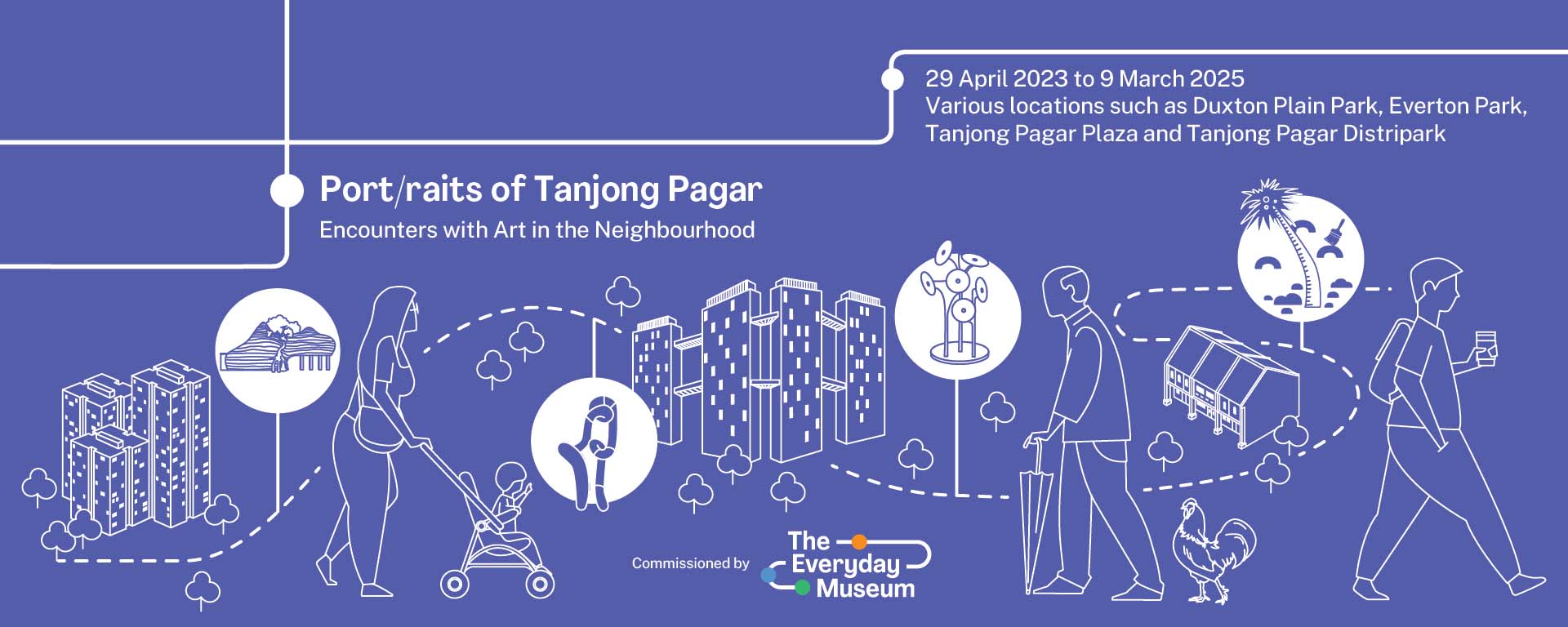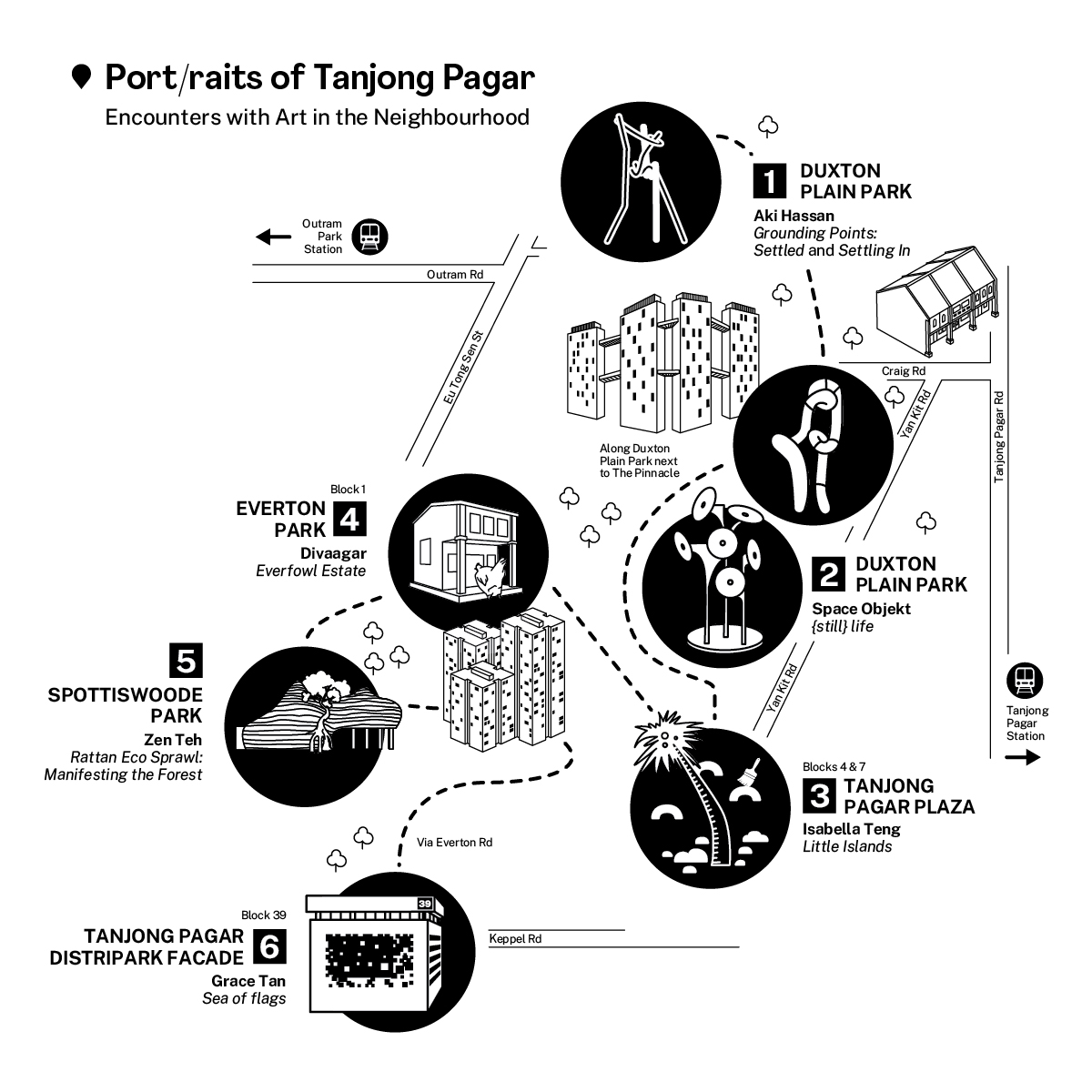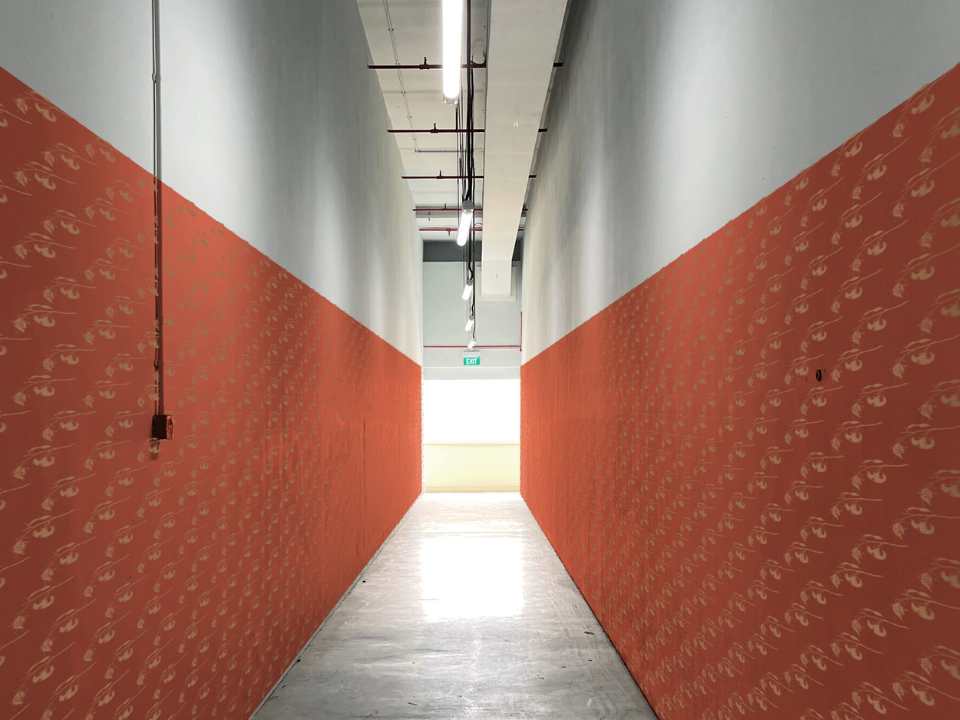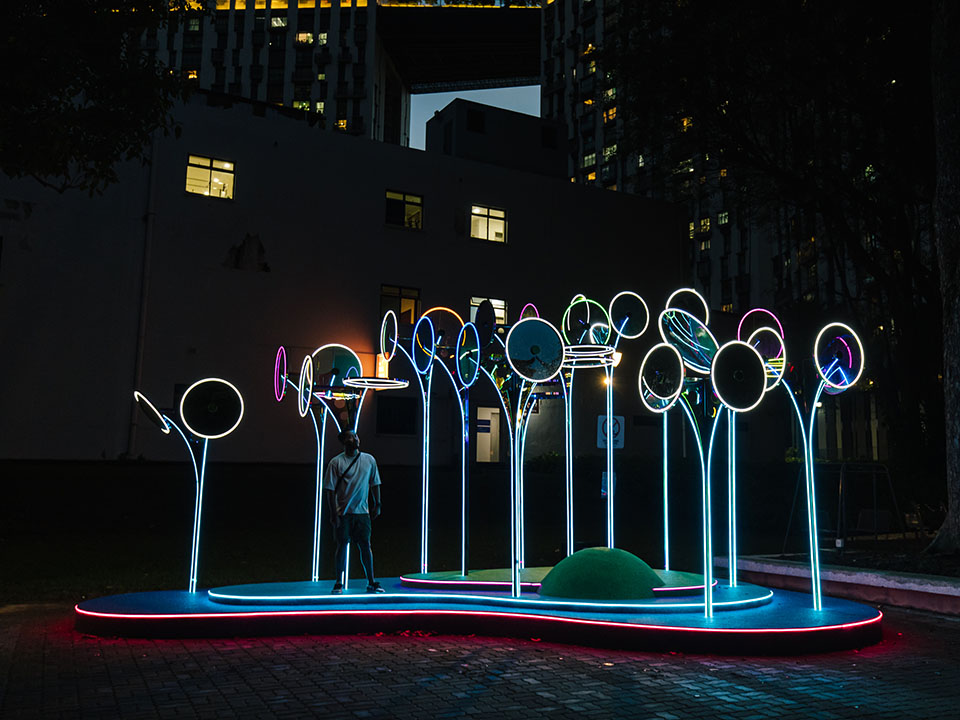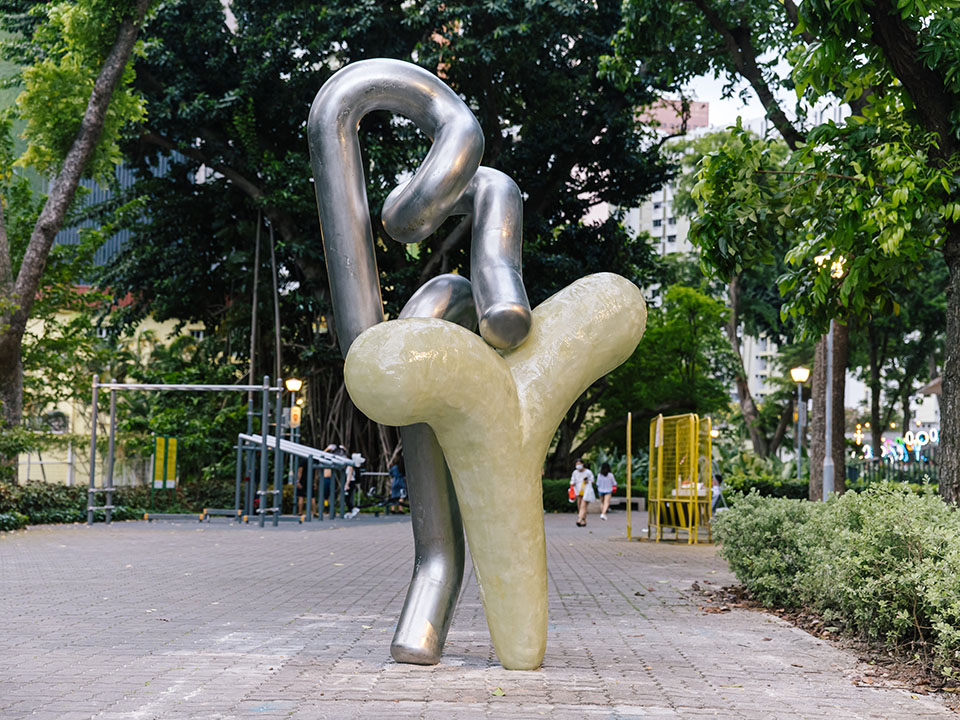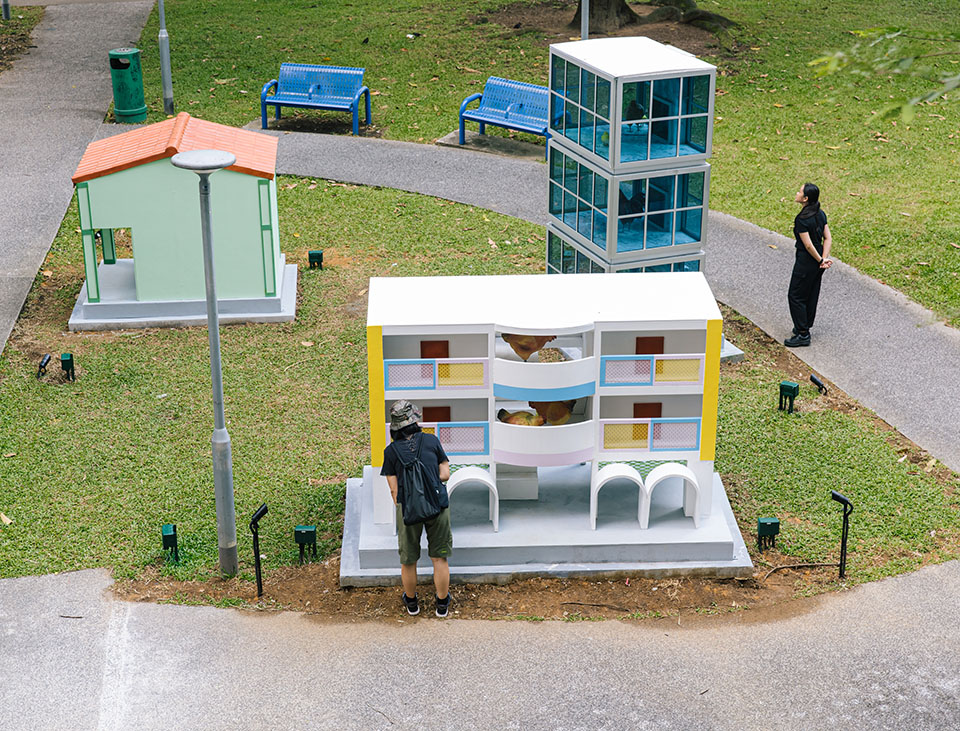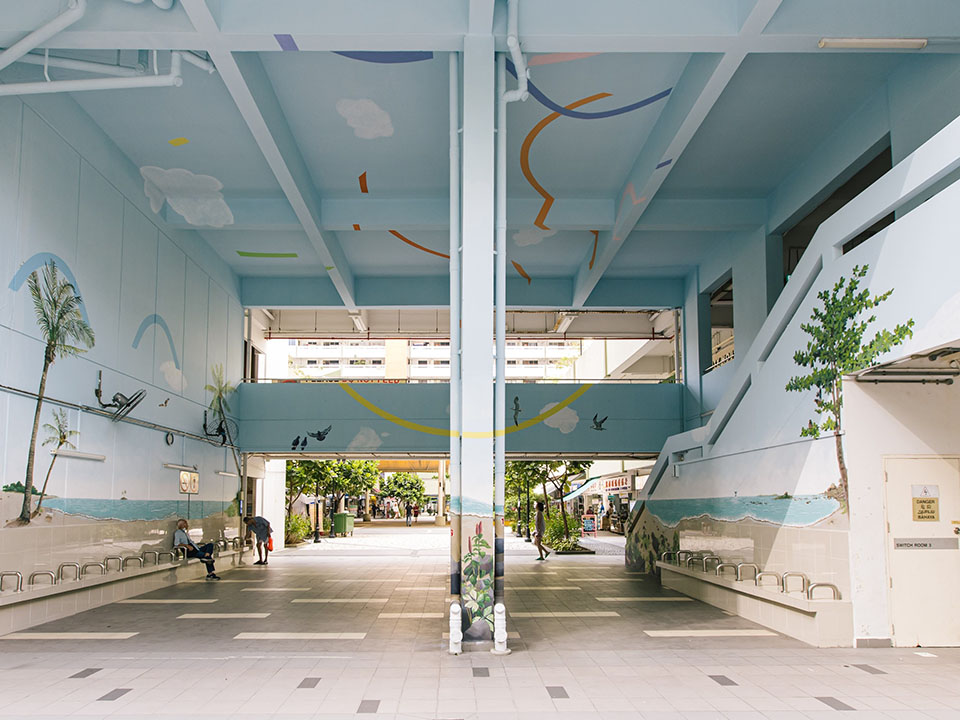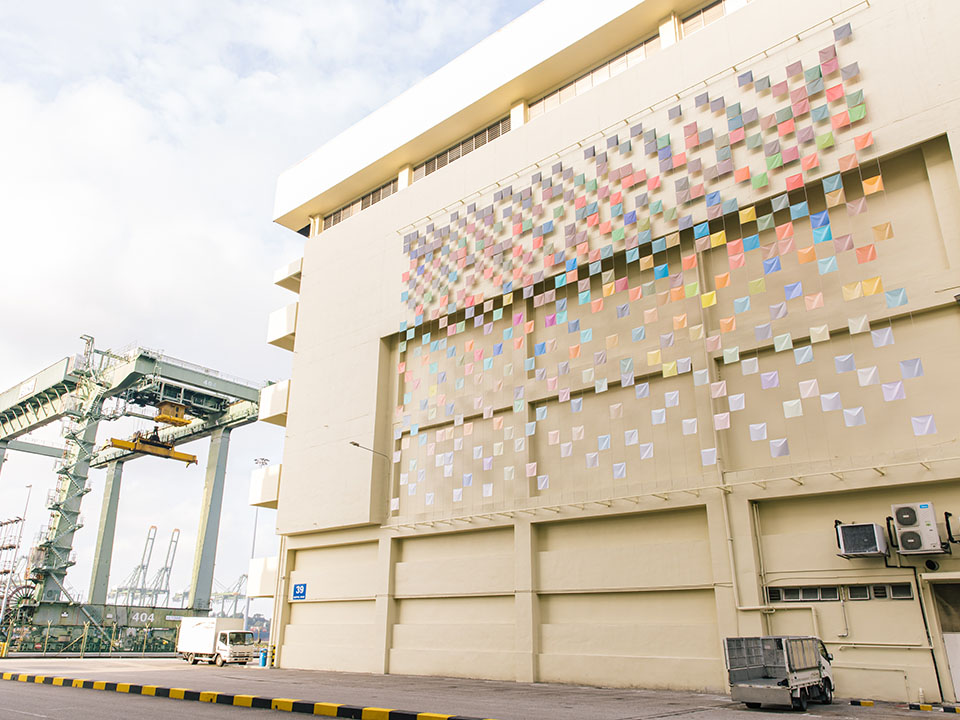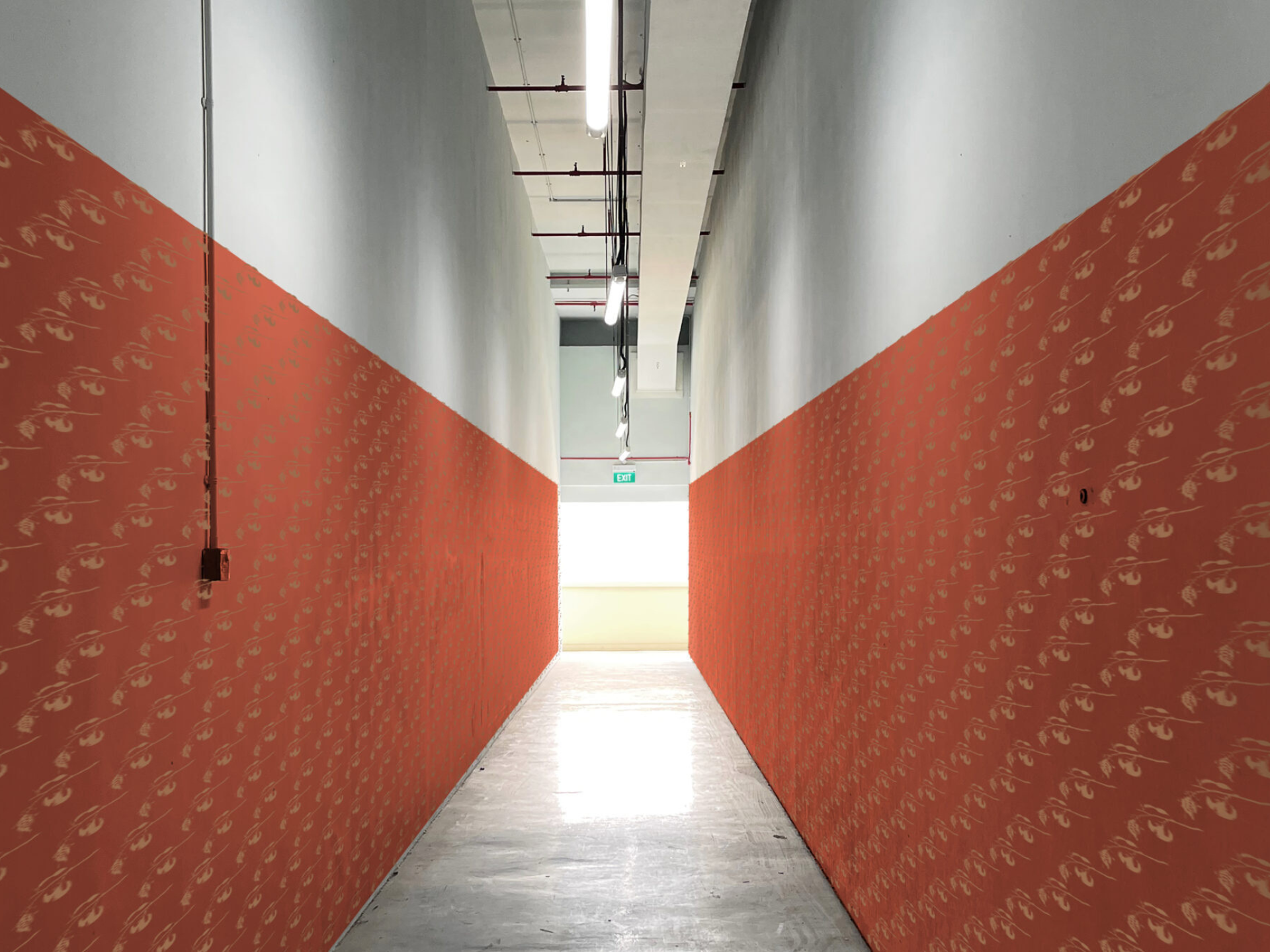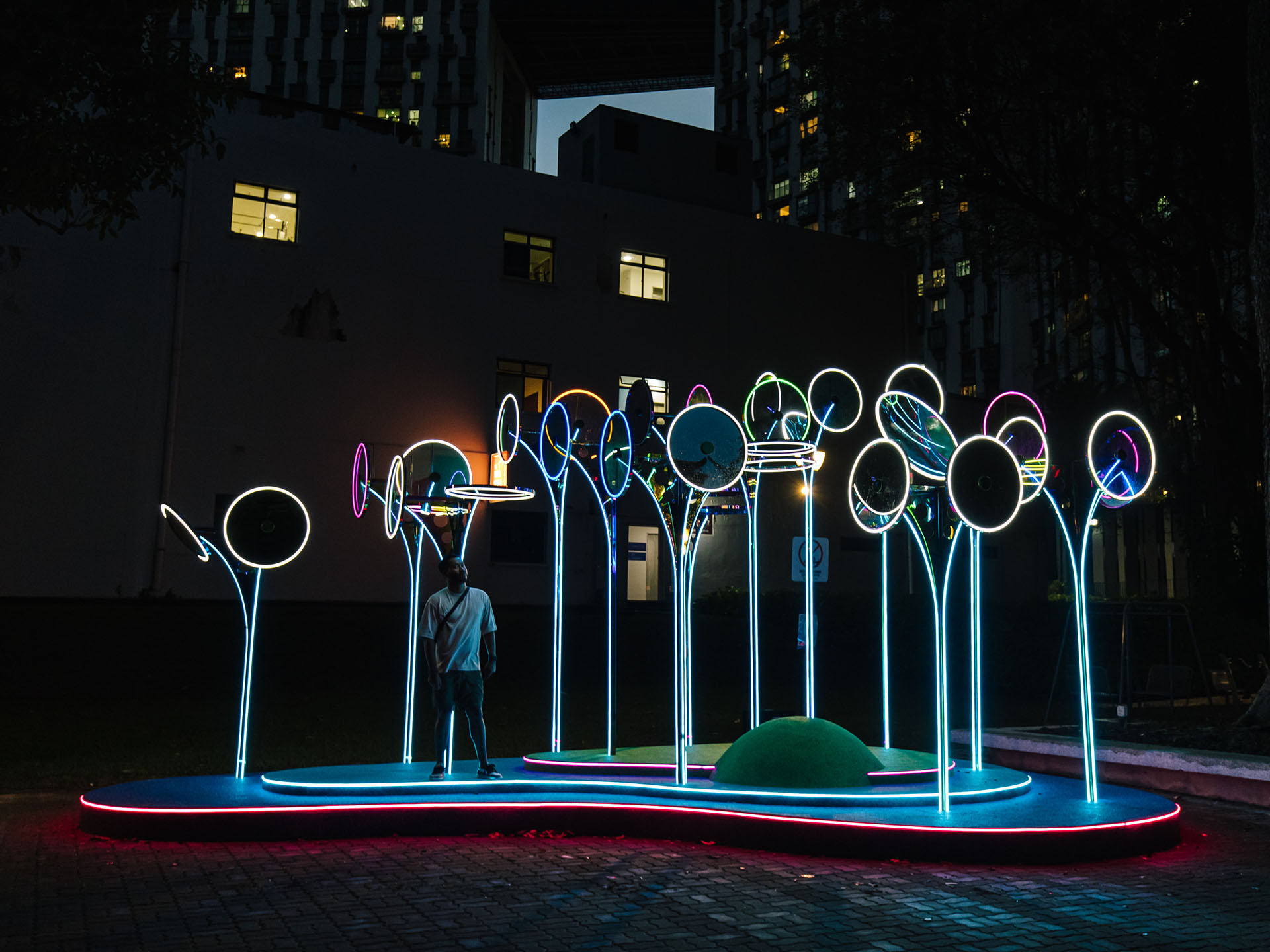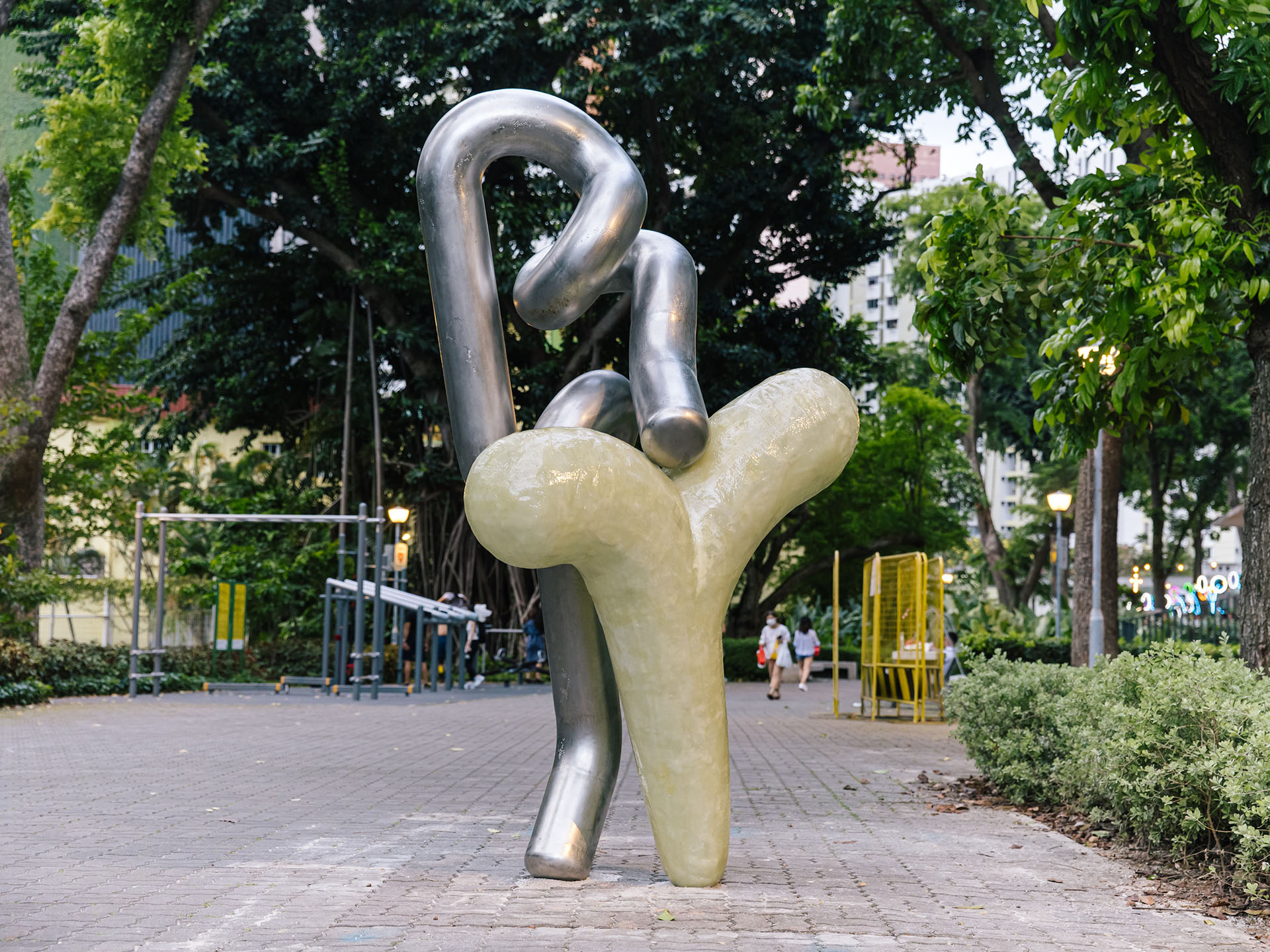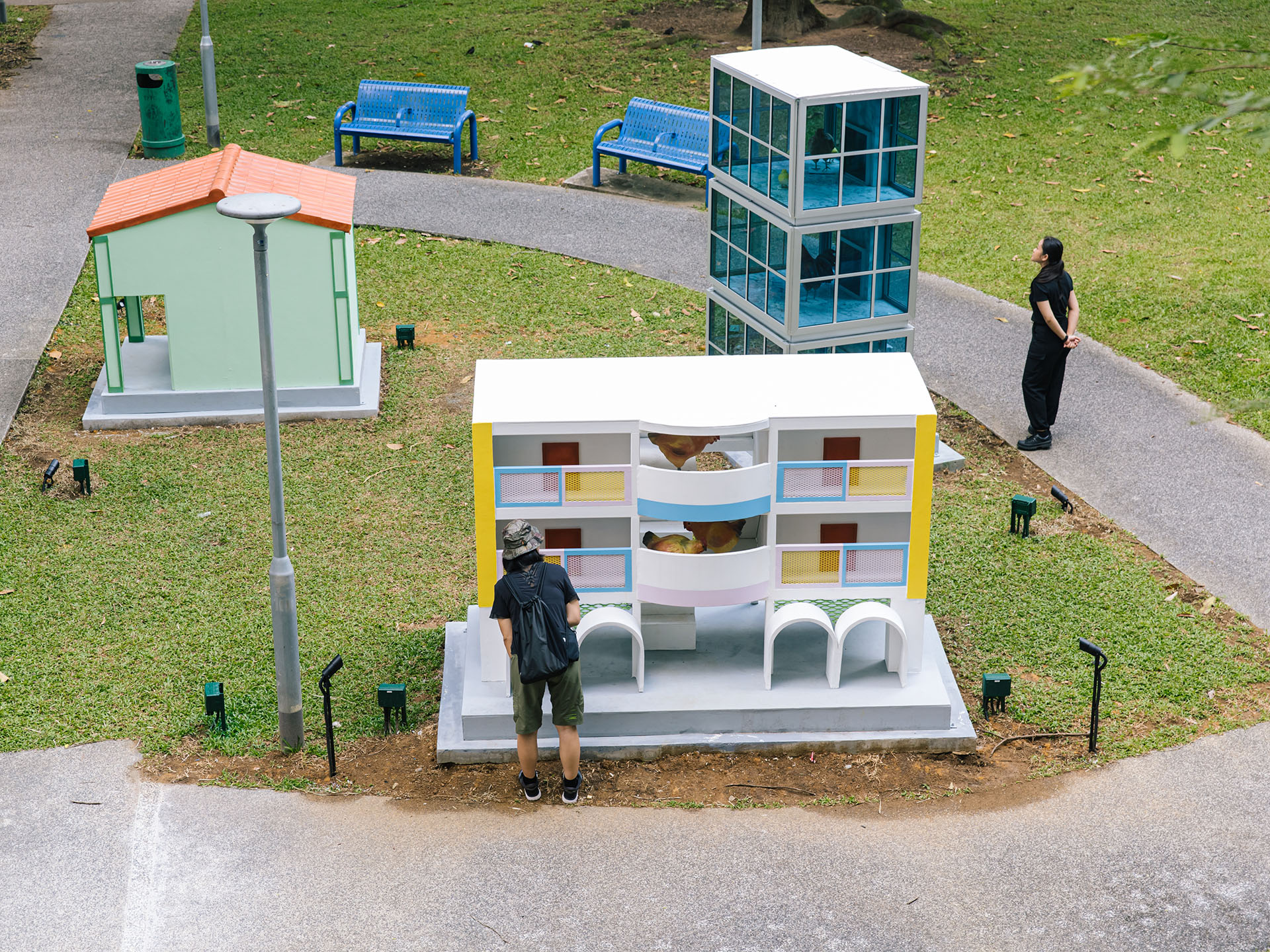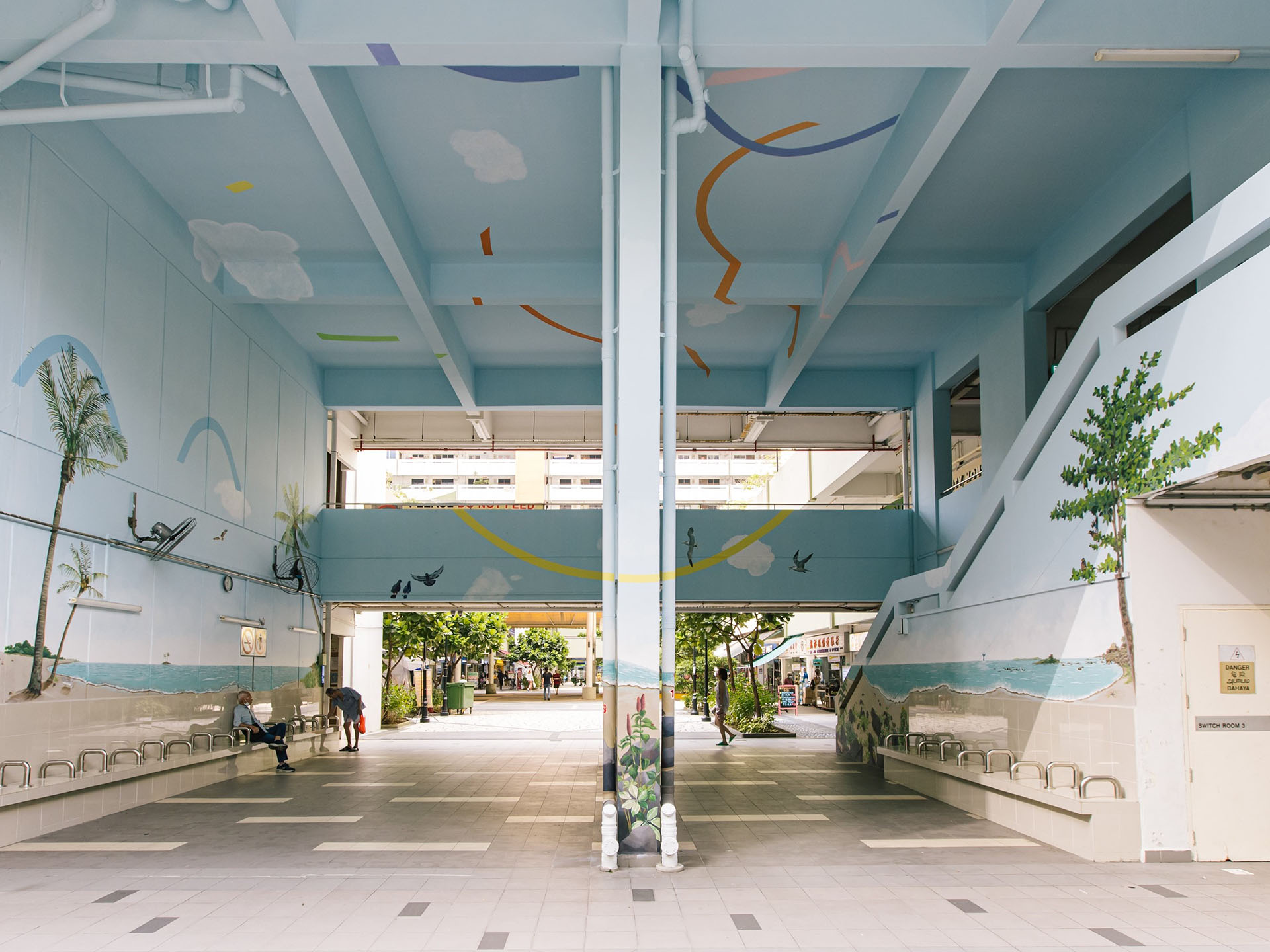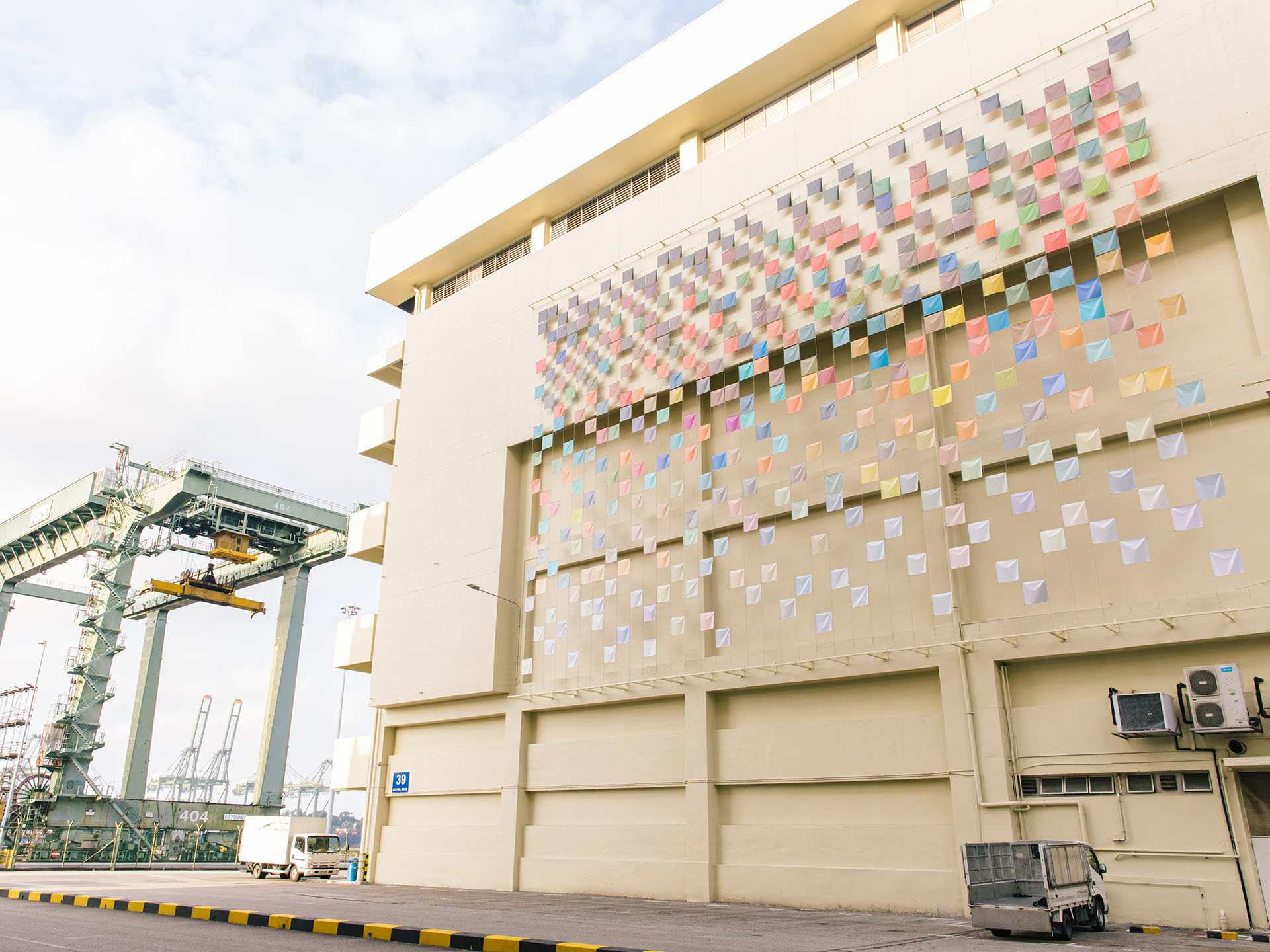Public outdoor work
Various locations in Tanjong Pagar
Port/raits of Tanjong Pagar
See Tanjong Pagar neighbourhood in a new light through a trail of lively art installations and discover its eclectic blend of old and new.
Across the public spaces between Outram Park MRT and Singapore Art Museum’s current location at the Tanjong Pagar Distripark, Port/raits of Tanjong Pagar showcases the dramatic transformations of the district over the decades, through a series of public artworks by six artists and collectives: Aki Hassan, Divaagar, Space Objekt, Grace Tan, Zen Teh and Isabella Teng.
By drawing attention to the complexities of urban life in contrast to the industrial and economic impacts that defined the written history of this district, the commissioned works in Port/raits of Tanjong Pagar suggest slowing down, taking in alternative perspectives of the vicinity, and discover the softer side of the neighbourhood, which is a testament to Singapore’s transition into a metropolis.
Port/traits of Tanjong Pagar is commissioned by The Everyday Museum, a public art initiative of Singapore Art Museum.
To find out more about the programmes and discover #ArtWhereYouAre, please visit

artwork highlight
related events
check out the line-up of free and ticketed events below!
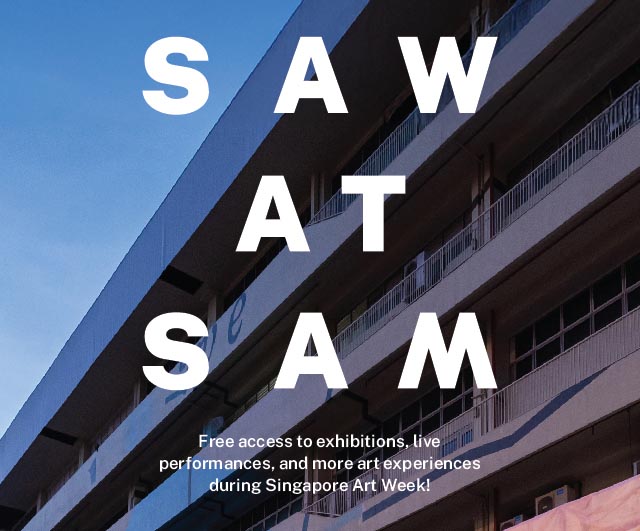 |
SAW at SAM
Catch live performances after dark, on 17-19 January, and a vibrant art market on 24-26 January. Enjoy free entry to exhibitions by Robert Zhao, Yee I-Lann, and Pratchaya Phinthong.
|
2024
Rattan, wood, tropical plants for forest restoration
Location: Spottiswoode Park (access path opposite Spottiswoode Residences)
*Visitors will not be able to enter the structure currently.
--------------------
Rattan Eco Sprawl: Manifesting the Forest nestles in the lush greenery of a quiet spot in the neighbourhood. Constructed primarily from rattan, its wavy forms weave in elements from the natural world including mountains and mounds where insects dwell. Such formations have also inspired sacred monuments like the Angkor Wat in Cambodia. Live plants encroach the work’s exterior while a glimpse into the interior, with its lowered ceilings and narrowed passageways, suggests care, not just for plants and species that inhabit it, but also for the mind. Witnessed here is the same jostle between natural and manmade elements in the area: tree roots pushing their way through concrete pavements, destabilising fences and bollards, etc., as if nature is attempting to reclaim its territory.
Rattan Eco Sprawl reflects on this entanglement of nature and urban development against the backdrop of a fast-changing Singapore landscape. It serves as a vessel for sonic encounters, embracing both manmade noise and the serenades of nature. Through engagements with rattan and wood artisans, an ecologist, and nonhuman residents, Rattan Eco Sprawl acknowledges the fragile, intertwined relationship that we share with nature, driving a collaborative need to bring old and new knowledges together for a sustainable future.
About the Artist
Zen Teh is an artist and educator interested in the interdisciplinary studies of nature and human behaviour. Her art practice spans across photography, sculpture and installation art. As a research-based artist, Teh has initiated numerous collaborative projects with artists, art professionals and scientists over the years to investigate the impact of rapid urban development in Southeast Asia. Teh has exhibited in numerous group and solo exhibitions in Singapore and the region, including National Museum of Singapore, Singapore Art Museum (SAM) and ArtScience Museum, Thailand, Indonesia, China, Korea, Taiwan and Germany and invited as a guest speaker at environmental conferences such as UNESCO-UNITWIN 2021, ASEAN Powershift 2015 and Hanoi Innovation Week 2016 on Sustainability. In 2021, Teh received the Young Artist Award by The National Arts Council, Singapore’s highest accolade for artists under the age of 35.
2024
Lime paint and ground nutmeg stencil application on wall
Location: Tanjong Pagar Distripark Block 39, Level 2 corridor, staircase and service balcony facing port
--------------------
At Block 39 of Tanjong Pagar Distripark, delicate floral garlands, pollination trails and nutmeg fruits embellish an exterior staircase and passageway. When first applied, the stencilled motifs in lime plaster and ground nutmeg emit a fleeting fragrance, reminiscent of how sailors in the 16th century claimed to detect the Banda Islands by their scent. Since the 6th or 7th century, nutmeg has been a rare and exotic spice from the “Far East” that influenced European taste and culture. Commercial nutmeg products today may seem unremarkable, but as one of the vestiges of Singapore’s colonial economy, it is synonymous with the promise of wealth, albeit one that turned out to be flawed.
Nutmeg (Myristica fragrans) was imported into Singapore in 1819 by Stamford Raffles in a bid to transform the island into a botanical research powerhouse of the British empire. The 1840s saw a period of “nutmeg mania” where large swathes of dense virgin forest lands were cut down for the cultivation of nutmeg trees in order to carry out the vision that “this island should all be cleared and cultivated; in fact become a large Garden.” One of these ambitious gardens was William Montgomerie’s residence, which was located amidst a 13 hectare nutmeg plantation with 1,800 trees in Duxton Road.
The fruit of deceit is a site-specific response to the history of Tanjong Pagar and its evolving identity. The notion of nature as a commodity is foregrounded here against the physical site of the old Keppel Harbour and present-day Tanjong Pagar Distripark—logistical nodes from different eras that facilitate the circulation of materials, goods, ideas, people and capital.
The gesture of overlaying the grimy surfaces of the building with a decorative stratum of nutmeg images subverts the identity of the place, while also creating new meaning. Applied deliberately in a repeated pattern, the surface embellishment is a human designed representation—an intervention to mark and colonise the space through the introduction of a foreign element. The nutmeg motifs in The fruit of deceit were taken from 19th century natural history illustrations that typically show a ripe nutmeg with the “red mace shining through the ruptured husk” and small inconspicuous lobed flowers. A plant that has both male and female reproductive organs but in separate individuals, the overabundance of female flowers functions as a trickery as only the lesser male flowers provide pollen. Nutmeg floral biology has no relation to its cultivation history in Singapore, but the concept of “pollination by deceit” uncannily parallels humanity’s precarious attraction to nature by terraforming the earth for the sake of “improvement.”
Nearby, in Grace’s other work, Sea of flags, 28 out of the 398 flags display colours referenced from the seed, mace, kernel, and skin of nutmeg. Each colour comes with a HEX code and corresponding RGB code, which was then printed onto a PVC sheet and made into a flag. The fruit of deceit extends this colour compendium of Tanjong Pagar through alluring visuals of the nutmeg, alluding to its slighted history in Singapore’s development.
About the Artist
Grace Tan is a multidisciplinary artist and designer with an interest in geometry, material and construction. From creating wearable fabric artworks under her kwodrent series, she has evolved into sculptural objects and site-specific installations. Tan was awarded the President’s Design Award for Building as a Body in 2012 and the Young Artist Award in 2013. In recent years, she has worked on large public art commissions in Singapore such as Woven Field at Downtown Line, Little India Station (2015), PLANES and CURRENTS at Marina One (2017), SYMMETRY at DUO (2017) and n. 333 – State of Equilibrium at Raffles City (2018). Tan has shown widely in Singapore, Australia, Japan, and the United Kingdom.
Artwork impression courtesy of the artist.
2023
stainless steel, anodised steel, glass, convex mirrors, neon flex LED, EPDM, dichroic film, solar film Approx. 790 x 570 x 400 cm
Location: Duxton Plain Park, Entrance at Yan Kit Road.
--------------------
{still} life presents reflective surfaces of varying sizes, encouraging viewers to peer into them. Strategically positioned for the unexpected encounter, the viewer gazes downwards to see the sky, and looks up to see the ground. Certain mirrors function as picture frames highlighting and contrasting specific details in the environment—old vs new, natural vs manmade, public vs private. —drawing closer the lesser-noticed and bringing the past a little closer to the present. This jostling of views that {still} life brings forth epitomises Singapore’s urbanity: around something historic or conserved, there is, often, a very modernised step-in.
The work takes inspiration from the environs of Duxton Plain Park and responds to the transitory nature of the site. Drawing on the genre of still life, it offers a snapshot of the park in this moment, inviting viewers to slow down and discover visual elements or perspectives that might not be apparent otherwise.
About the Artist
Space Objekt is a Singapore-based boutique design studio reshaping the understanding of built
environments and creating memorable experiences where people interact within. With a shared
vision of making art accessible to all, founders Tina Fung and Ash Razaque hope to connect
audiences with the physical world through their immersive, large-scale installations.
Ash Razaque has worked for some of the biggest production houses and venues in Singapore
including The Esplanade and Resorts World Singapore, before turning his focus to
entrepreneurship.
Tina Fung is the principal set designer and artist of Space Objekt. A graduate of Chelsea College
of Art & Design, University of the Arts, Fung has more than a decade of experience working in
Copenhagen, London, and Singapore.
2023
Stainless steel, fibreglass 180 x 50 x 280 cm and 120 x 120 x 270 cm
Location: Duxton Plain Park, Entrance at New Bridge Road
--------------------
The two sculptural forms situated in the Northern and Southern points of Duxton Plain Park, Grounding Points: Settled and Grounding Points: Settling In accentuate notions of support systems and dependencies reflected in our contemporary landscape. Interlocking two distinct materials in each sculpture, their bodies—although seemingly balanced from afar—can be seen leaning on each other.
Grounding Points: Settled and Grounding Points: Settling In take their cue from the familiar materials around us, natural and man-made. Like the park nestled in the bustle of the concrete cityscape, the artwork is inspired by structural elements from these shared spaces. Mirroring species of tree to metal forms found throughout the park, the artwork pays homage to reciprocal connections and kinship between the synthetic and organic, as well as humans and nonhumans.
About the Artist
Aki Hassan (b.1995, Singapore) is a visual artist who works primarily across sculptural
installations and print making. Reflecting on systems of social support, they see their practice as
a way to locate strength, resistance and solidarity within the vulnerable. They have participated in
residencies such as Cutes / ظرافِ with Samandal and Nino Bulling, as part of documenta 15
(2022), and at Singapore Art Museum (2021/22). Their work was recently exhibited at RSA New
Contemporaries 2022, Royal Scottish Academy (2022), innate, Yeo Workshop (2021), An
Exercise of Meaning in a Glitch Season, National Gallery Singapore (2020), Pig Rock Bothy
Residency & Exhibition, Scottish Gallery of Modern Art (2019) and Show Me The Difference,
Studio for an Art Lover, Glasgow (2019).
Production Credits:
Project Manager, Design & Fabrication Lead: Sean Gwee, Made Agency
Fabrication Co-lead: Quek Yu Han, Made Agency
Fiberglass Fabrication Lead: Woon YingJie Jenevieve
Fabrication Assistants: Rusydan Norr and Chok Si Xuan
2023
Fibreglass Reinforced Polymer (FRP), Glass Fibre Reinforced Concrete (GFRC), acrylic, plaster, aluminium, steel, polyurethane foam, formica, acrylic emulsion paint; various dimensions
Location: Location: Everton Park, in front of Block 1
--------------------
Everfowl Estate is a playful proposition introducing civilised living to the many feathered folks inhabiting the neighbourhood. Modelled after the surrounding neighbourhood for its historical and contemporary architecture—public housing flats, heritage shophouses or high-rise condominiums—, the series of miniature homes is a showroom display fitted with models of fowl families, offering visions of modern living for the junglefowl citizens of Tanjong Pagar.
The backdrop of the work is Everton Park, one of the oldest public housing estates in Singapore. Situated at a unique intersection of newer developments, older businesses and ongoing revitalisation projects, Everton Park has remained relatively unchanged. In referencing this eclectic mix of architecture and the local junglefowl population, Everfowl Estate conceives a diorama of the distinctive conditions of the neighbourhood and challenges viewers to consider their surroundings from a macro perspective.
Everfowl Estate’s projection of harmonious living with our nonhuman residents examines the way city habitants engage with public spaces which can serve as a forum, a habitat for various flora and fauna, a place for congregation, recreation and sometimes contention between humans and non-humans, embracing both the tensions and kinship that come with it.
About the Artist
Divaagar (b.1992, Singapore) is a visual artist who creates installations, performances, and
digital media. His practice examines narratives and proposes new models by rethinking how
bodies, identities and environments interact. He graduated with a Bachelor of Arts (First Class
Honours) in Fine Arts from LASALLE College of the Arts in 2018 and has exhibited both locally
and internationally since 2010. He has had two solo presentations thus far: Between a rock and a
hard place, part of a summer residency in Untitled Space, Shanghai and The Soul Lounge at
soft/WALL/studs, Singapore. Notable group exhibitions include MENTAL: Colours of Wellbeing,
ArtScience Museum; State of Motion 2021: [Alternate / Opt] Realities, Marina One, and Time
Passes, Singapore Art Museum.
Production Credits:
Fabricators: Chagall 3D Advertising
2023
Three anamorphic site-specific installations, various dimensions.
Location: Tanjong Pagar Plaza, Blocks 4 and 7
--------------------
Referencing Singapore’s acknowledged status as a “little island”, Little Islands attempts to subvert the notion of limited space through artistic interventions which offer a visceral experience of spaciousness to the viewer. The artworks across three sites in Tanjong Pagar Plaza offer different experiences of “island life", revisiting and reinventing our relationship with Singapore as an islandstate.
At the Residents’ Corner of Block 4 on Level 1, the work considers “island” in its most literal form: a geological landmass surrounded by water. The work at Block 7, Level 3, considers our past, as we gaze back to early 20th century scenes with restored views of historic shophouse architecture, allowing us to visualise the passage of time. The visual intervention at Block 4, Level 3, offers a whimsical take on an incongruous, floating island hidden in the far reaches of Tanjong Pagar Plaza, reflecting the plaza’s reality as an old 1970s public housing estate, standing firm amid newer, taller and shinier buildings.
Amid the bustle, Little Islands beckons you to stay a while
About the Artist
Isabella Teng Yen Lin (b. 1990, Singapore) is an artist working across painting, drawing and
public installations. Her practice focuses on anamorphic artwork, or optical illusions, that
transform everyday spaces into imaginative realms and prompt a perceptual shift through
humour or encounters with the unexpected. Her projects examine the nature of perception
through the intersection of line, text, space and illusion. Teng’s works have been shown at
Esplanade Theatres by the Bay, The Private Museum, National University of Singapore, and
ASEAN Culture House, Busan.
Little Islands is supported by HDB Lively Places Programme.
Production Credits:
Production Manager: Pierre Pourville
Mural Art Specialist: Grace Chen
Artist Painters: Peng Ting, Goh Hong, Yunita Rebekah, Iqbal Roslan, Jasmine Yeo Jia Min,
Vicky Kok Hui Yi, Kimberly Teo, and Ma Win Sandi Kyaw, with contributions from the residents
of Tanjong Pagar Plaza
Work-at-Height Specialists: Meah Anis and Rahman Md Lutfar
2023
398 Digital UV prints on PVC hoisted on tension cables with stainless steel fasteners, dimensions variable
Location: Tanjong Pagar Distripark, Block 39 Side Facade (facing Block 37)
--------------------
Sea of flags engages with the history and identity of Tanjong Pagar and is a tribute to the memory of the district’s massive development over two centuries. The flags that make up the installation are an assemblage of material swatches colour-matched with physical objects and digital images of the area. Consolidated from over 400 colours, these swatches are derived from the landscape and architecture, natural and man-made materials that have defined the vicinity’s industries of the past.
The colours of crimson, orange, pale yellow and brown, highlight the fruit plantation history of the land in the 1800s, where gambier, nutmeg and mace, pepper and pineapple were once cultivated. Land reclamation from as early as the 1840s and the construction of wharves and docks substantially transformed Tanjong Pagar’s coastal landscape – several hills such as Mount Wallich, Cursetjee Hill, part of Mount Palmer, Keramat Hill, Bain’s Hill and Guthrie Hill were levelled to reclaim land from the swamps.
Moving like a ripple with the wind, Sea of flags’ presence on the reclaimed land where Tanjong Pagar Distripark stands today signifies the fleetingness of the physical world where spatial boundaries are indeterminate. Constantly shifting and blurring, they evoke the capricious movement of the surrounding sea.
About the Artist
Grace Tan (b. 1979, Malaysia) is a multidisciplinary artist and designer with an interest in
geometry, material and construction. From creating wearable fabric artworks under her kwodrent
series, she has evolved into sculptural objects and site-specific installations. Tan was awarded the
President's Design Award for Building as a Body in 2012 and the Young Artist Award in 2013. In
recent years, she has worked on large public art commissions in Singapore such as Woven Field
at Downtown Line, Little India Station (2015), PLANES and CURRENTS at Marina One (2017),
SYMMETRY at DUO (2017) and n. 333 – State of Equilibrium at Raffles City (2018). Tan has shown widely in Singapore, Australia, Japan, and the United Kingdom.
Production Credits:
Artist Assistants: Lewis Ten, Li Si Yi, and Mervyn Chen

